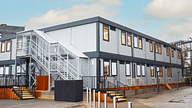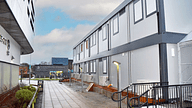Pickerings Breaking Modular Myths in Education
When people hear "modular buildings" in the context of schools, many picture boxy, beige structures tucked behind main buildings. They can be seen as uninspired, low-cost, and even lower quality. But this stereotype doesn't match the reality of modern modular construction.
Today’s modular learning spaces are smart, sustainable, and often indistinguishable from traditionally built facilities. So why does the outdated image persist? It’s time we unpack the myths and reimagine what modular can mean for education.
Myth 1: Modular Means Temporary
One of the most persistent misconceptions is that modular buildings are short-term solutions meant to be removed or replaced quickly. While it's true that modular construction can be deployed faster than traditional builds, this speed doesn’t compromise longevity. In fact, many modular school buildings are engineered to last 30 years or more, with durability that matches or exceeds conventional structures. School districts across the country are choosing modular not as a stopgap, but as a smart, long-term investment.
Myth 2: Modular Lacks Design and Innovation
Today’s modular classrooms are designed with flexibility, aesthetics, and education in mind. High ceilings, ample natural light, acoustic insulation, and customisable layouts make these spaces ideal for modern teaching methods. Want a STEM lab, collaborative learning hub, or even a music room with soundproofing? Modular design can deliver all of that - and often more quickly and affordably.
Myth 3: Modular Buildings Aren’t Sustainable
In fact, modular construction is often more sustainable than traditional methods. Because most components are fabricated in controlled environments, reduced site disruption, and a smaller carbon footprint. Many modular school buildings now include green roofs, solar panels, and energy-efficient systems as standard options. Plus, the ability to relocate or repurpose modular units extends their lifecycle and limits environmental impact.
Myth 4: Modular Is a Budget Compromise
While modular can be more cost-effective, that doesn’t mean it sacrifices quality. The efficiencies gained - faster timelines, streamlined labour, reduced delays - translate into lower overall costs without diminishing the student experience. For areas managing tight budgets and growing student populations, modular construction provides an opportunity to expand quickly while still prioritising comfort, safety, and educational excellence.
Reimagining What’s Possible
It’s time to stop seeing modular as a compromise and start seeing it as a catalyst. A catalyst for agility in planning, for innovation in design, and for equity in educational access. As schools face evolving needs - from population shifts to new learning models - modular construction offers a smart, scalable solution that meets the moment.
So let’s move beyond the beige boxes. The future of education deserves spaces that are just as dynamic as the students and educators inside them. Modular isn’t just a different way to build - it’s a better way to think. Take a look at our Principal range for more information.

